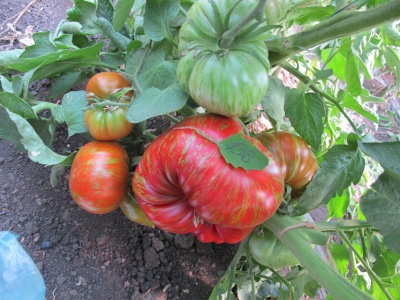
- Authors: Brad Gates, USA
- Name synonyms: Berkeley tie dye heart
- Category: grade
- Growth type: indeterminate
- Appointment: universal
- Ripening period: early
- Ripening time, days: 105-110
- Growing conditions: for open ground, for greenhouses
- Bush size: tall
- Bush height, cm: 180-200
Berkeley tomato Tai Dai Haat has good marketability and taste. Popular with both amateur gardeners and industrial producers.
Breeding history
The tomato of this variety is a native of the United States. It was there that Brad Gates brought him out, gave him such an interesting name for his amazing color.
Description of the variety
The plant of this variety grows quite large in comparison with other tomatoes. It is indeterminate, does not stop growing. Reaches 180 cm, and sometimes 200 cm. A vigorous bush, usually has 2 main stems on which dark green leaves grow. It is versatile in terms of use.
It has a slight disadvantage. He has excess vegetation.
The main qualities of the fruit
The tomato of this type has fruits of an unusual flat-round shape, resembling a heart. The color is three shades, a predominant bright red turning into a dark burgundy with a pattern of strokes. In the context of a brown-chocolate shade. Even unripe green tomatoes have shading. Quite large by weight, from 250 to 300 g. The flesh of the fruit is dense and fleshy, covered with a thick skin on top. They contain almost no juice inside. Which is a big plus in making salads from them.
Taste characteristics
It has a very bright sweet taste with light fruity notes. Well suited for fresh consumption, as well as for drying and blanks, but for this it is cut into pieces. It is not processed as a whole. It is also used to extract juice.
Ripening and fruiting
This type of plant is suitable for growing outdoors and in greenhouses. In the latter case, it ripens earlier. Fruiting from July to September, during all 3 months. The first crop is harvested in July, which is considered an early date. From germination to fruiting, it takes from 105 to 110 days.
Yield
This variety has high fruiting. When grown in a greenhouse, it can yield about 10-12 kg of yield per square meter of planting area.
The timing of planting seedlings and planting in the ground
Seeds are recommended to be planted for seedlings around March 1-15. When the first large leaves appear on the plant, you can prepare the seedlings for planting in the ground. Seedlings are planted around mid-May or June 1.

Growing tomato seedlings is an extremely important process, because it largely depends on whether the gardener can harvest at all. All aspects must be taken into account, from seedbed preparation to planting in the ground.
Landing scheme
Plants are planted in soil at 50 days of age. The distance between the plants should be at least 60 cm. The planting density per square meter should be no more than 3 plants. The depth of the tomato pits should be about 40 cm.

Growing and care
For this type, grooming procedures such as pinching, shaping and garter are recommended.
Grassing is the removal of the upper buds to stop the growth of the plant and give it the opportunity to direct its forces towards fruiting. This procedure is important for tomato as it is an indeterminate variety.
Formation is required because this plant is very spreading and tends to grow to the sides.
The garter is recommended because of the tallness of the tomato, so that it does not fall or bend under the weight of the fruit.
When watering, you need to ensure that the water does not irrigate the foliage. And also the temperature of the liquid should be + 18 ... 25 degrees. It is better to carry out the procedure in the morning or in the evening.




A plant needs different micronutrients at each stage of growth. All fertilizers can be divided into two groups: mineral and organic. Folk remedies are often used: iodine, yeast, bird droppings, eggshells.
It is important to observe the rate and period of feeding. This also applies to folk remedies and organic fertilizers.
Disease and pest resistance
It has good resistance to diseases such as fusarium.


Resistant to adverse weather conditions
It is very sensitive to temperature extremes and sudden changes in weather. Experiences these phenomena as stressful situations and may stop growing.
Review overview
Amateur gardeners who have tried to grow this variety note its amazing taste, as well as the fact that it does not crack. But they also note a small minus. Many did not like his love for the sun's rays, since without a sufficient amount of them, he does not ripen or bears fruit very late. But everyone, without exception, noted its interesting shape in the form of a heart.
Overall a very versatile variety. Possesses good taste, has a wide field of application, and is also well stored and does not have a lot of liquid in its composition. The only thing that has a high spreading and therefore needs shaping and pinning. But such a slightly complicated care should not scare off gardeners who want to grow it.A large harvest will cover all the effort spent.

























































































